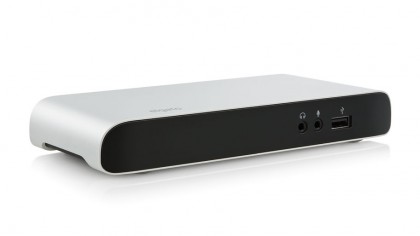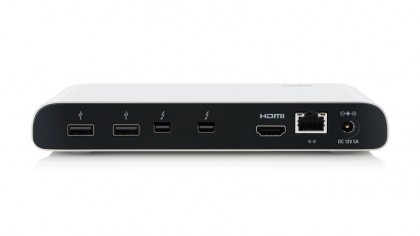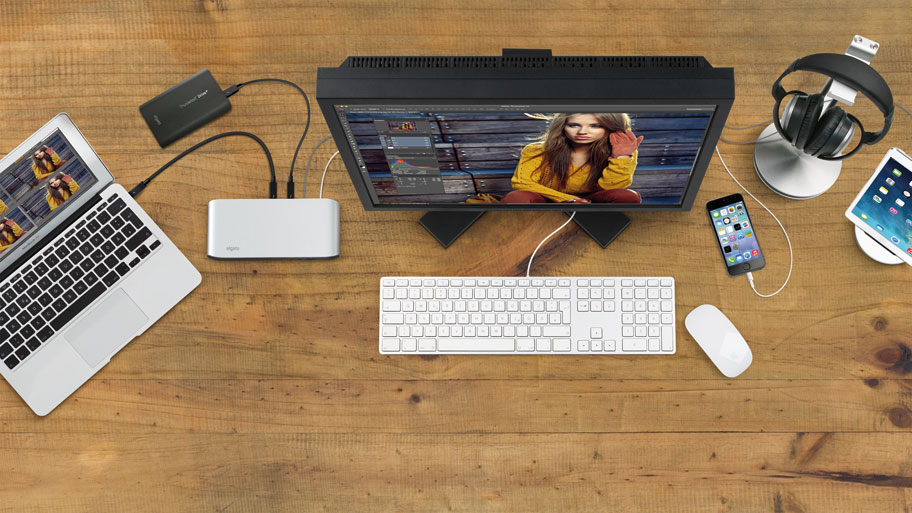TechRadar Verdict
Though very similar to rival products the Elgato Thunderbolt Dock does have the promise of fast USB ports. It's the best-specced Thunderbolt dock to date.
Pros
- +
Compact and attractive design
- +
Passthrough port for further expansion
- +
HDMI 1.4 port supports better-than-HD displays
Cons
- -
Clear limit to USB 3.0 performance
- -
No FireWire or eSATA ports
Why you can trust TechRadar
Most Macs sold since 2011 have at least one Thunderbolt port, yet many people use it only to connect an external display, ignoring the port's greater potential. Thunderbolt's versatility can be leveraged to add new features to a computer, even when that computer's design doesn't accommodate internal expansion cards.
The simplest examples of this are adaptors that turn a Thunderbolt port into an Ethernet or a FireWire port. But docking stations like this one from Elgato are more adventurous, providing multiple ports for you to connect various devices including storage, a printer, a display and more. This is especially convenient with a portable Mac because things can be reconnected whenever you return to your desk by simply plugging in one cable.
The dock works with desktop Macs too, and that makes it of special interest if you own a first-generation Thunderbolt Mac and lament its lack of USB 3.0 ports. It gives you three of them, thereby unlocking new options for fast external storage.
Bear in mind, though, that this doesn't mean you can use all kinds of USB 3.0 hardware with a Mac. Some video capture decks, for instance, come only with Windows software, so it's necessary to verify compatibility.

On the surface Elgato's line-up of ports isn't much different to earlier alternatives from Matrox and Belkin. The front panel contains one USB 3.0 port and discrete 3.5mm mini jacks for headphones and a microphone. This is a welcome change from Apple's annoying habit of putting useful connections out of sight and easy reach.
At the back are another two USB 3.0 ports, beating the quantity on Matrox's dock, which also has a total of three USB ports, but two of which are rated only for USB 2.0 transfer speeds. Belkin's dock has three ports of the more modern type. However, the ports on both of these alternatives are limited to 2.5GB/s, whereas Elgato rates its ports for USB 3.0's theoretical maximum of 5GB/s. Its ports also support UASP (USB Attached SCSI Protocol), which is capable of delivering improved transfer rates (something that will be covered later in this review).
The rear panel also contains a HDMI 1.4 port, which is able to drive a display with a resolution up to 2560x1600 pixels; a Gigabit Ethernet port, which most recent MacBooks lack; and two Thunderbolt ports. One Thunderbolt port connects the dock to your computer, while the second allows additional devices to be connected through the dock.
Alternatively, this extra Thunderbolt port can be used to connect a DVI or VGA display if you already have a Mini DisplayPort adaptor for that purpose. Or you can convert it to an increasingly niche FireWire 800 port with a different adaptor. Belkin's dock has FireWire built in.

Using one of these adaptors cuts off further expansion unless you ensure your other Thunderbolt devices have their own passthrough port, in which case you can daisy-chain those devices and connect the adaptor last in the chain.
Also omitted, and even more niche on the Mac, is eSATA. Another dock from Sonnet Technology promises to include two eSATA ports, but that product is yet to become available a year after its announcement.
The dock's mix of metallic and black panels is a good fit for Mac hardware, and it fits on the foot of an iMac's stand. But don't mistake its size as an indication of portability because the included power brick is required.
